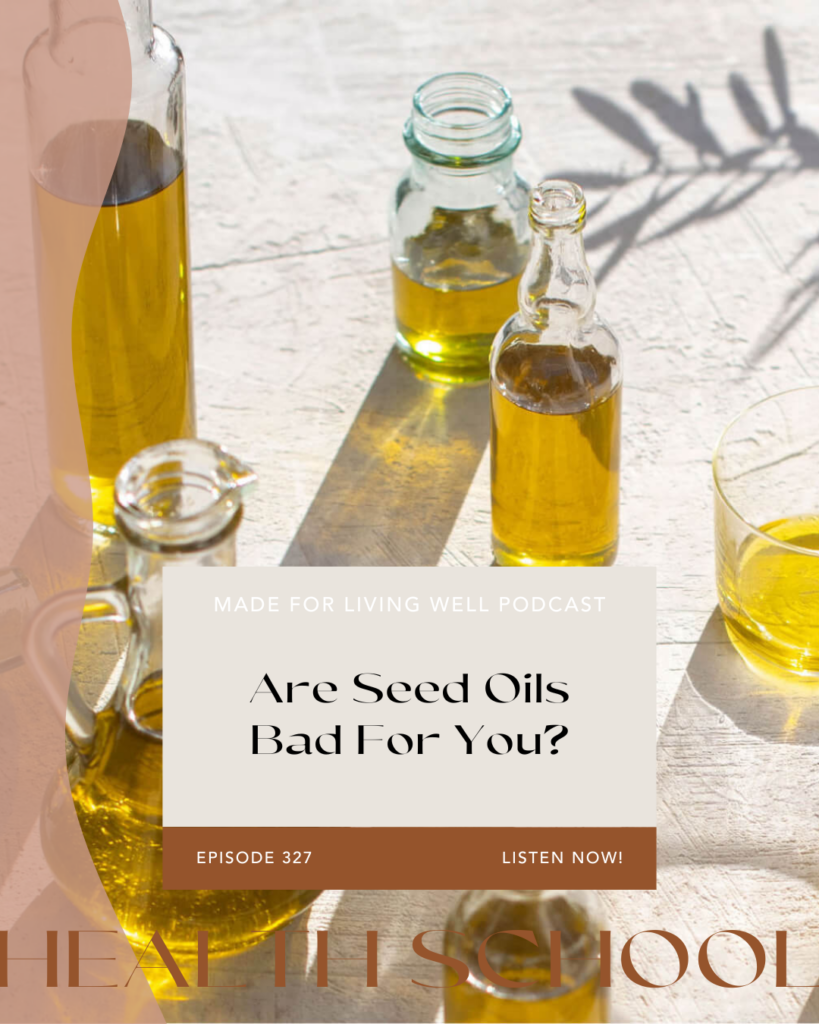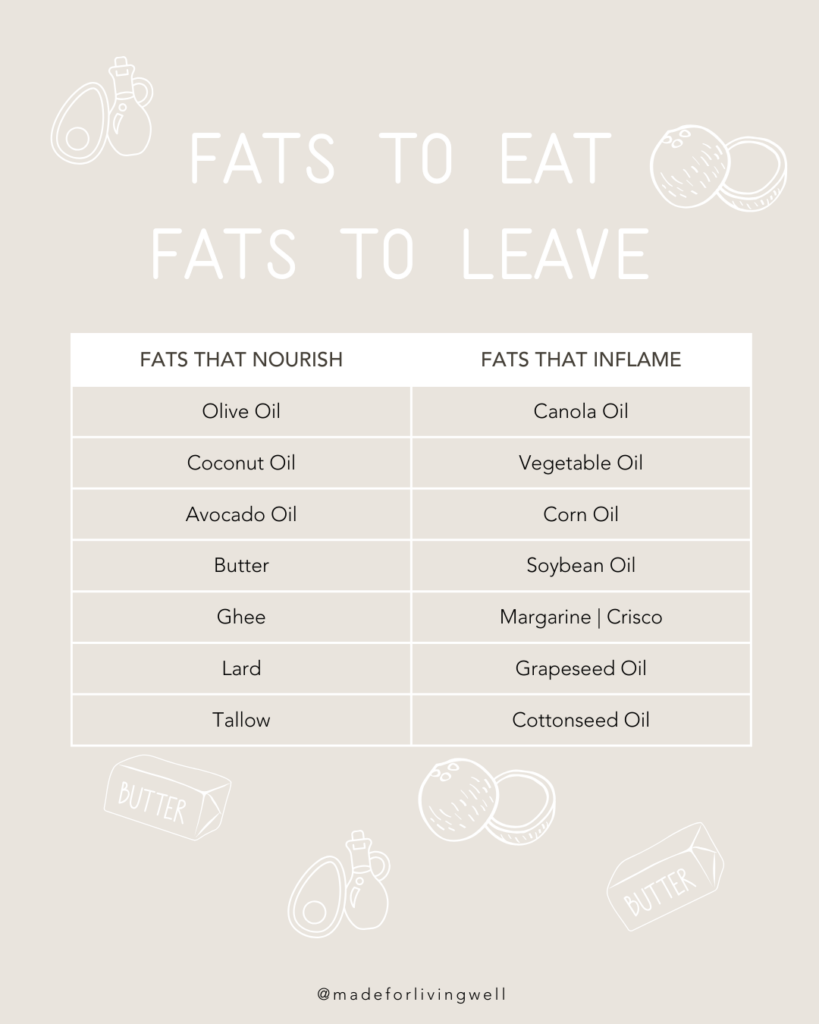
Listen on iTunes | Listen on Spotify | Listen on YouTube | Review the Podcast
There’s a lot of chatter in the health space about seed oils, which has opened up all kinds of room for confusion. But today, I want to clarify the answer to the question: Are seed oils bad for you?
Not to throw shade at another food. We all know we can’t possibly risk losing one more staple in our diet and feel okay about it. We’ve shamed sugar, potatoes, carbs, and even fats. Fats were the first food on the chopping block as the health industry began exploding in the early 80s.
It was the same then and the same now. Researchers were trying to identify the cause of our rising health problems, which seem to grow exponentially every year. The study responsible for the correlation made between fat consumption and rising disease has since been debunked.
But that study opened the door to a fear of food we’ve repeated over the following decades. The food industry willingly and quickly picked up on this fear, leaving you turning to their “healthier” options like factory-made butter known as margarine.
Ironically, the same fats we once thought were the vain of our existence we now understand as critical to survival.
But the part that leaves me most upset and you most confused is that we’ve misunderstood how our body responds to fats. We’ve neglected to understand the role of certain fats inside the body, which is the only way to identify what is good or bad for you.
While this is a personal question, like all concepts in the health space, in this podcast, I provide an overarching framework on if and how to consume seed oils.
Are seed oils bad for you? Get the answer inside this podcast.
Seed Oil Swaps
There are five main reasons I’m not a fan of seed oils. The primary issue regards the concentration of omega-6 fatty acids inside seed oils. While omega-6 fatty acids are necessary for health, the ratio we currently consume them compared to omega-3 is arguably causing health problems.
Omega-6 fats produce inflammatory properties inside the body. Again, in the right ratio, this is necessary for health and survival. But at the levels we consume them, they create a constant inflammatory state inside our body. Over time, this leads to premature disease, autoimmunity, and even cancer.
What used to be a ratio of one to one has turned into a ratio of fifteen, even twenty to one.
Unfortunately, bringing the ratio into balance by consuming more omega-3s isn’t the answer. While it can be beneficial, the enzymes needed to break down omega-3 and omega-6 are shared. When the ratio is so out of balance, this causes competition in metabolism, with omega-6 winning out.
For health, it’s important to reduce or eliminate the use of seed oils to lessen the inflammatory burden in your body.
Eat This, Not That
To reduce omega-6 oils, you have to get to know them. Because they’re cheap, they’re used in the processing industry, and you’ll find them in almost everything.
However, there are always alternatives, which I share with you in this post.
But first, here is the list of the most commonly consumed seed oils.

Leave these oils:
- Canola oil
- Soybean oil
- Vegetable oil
- Grapeseed oil
- Sunflower oil
- Cottonseed oil
Again, these appear in nearly every processed or fried food. Pay attention by reading the food label. Look at the ingredients list, and avoid foods that use seed oils. Swap them out for these healthier options.
Eat these oils:
- Olive Oil
- Coconut Oil
- Butter
- Ghee
- Grass-Fed Lard
- Avocado Oil
Tips To Make The Switch
Admittedly, this transition isn’t as easy as it sounds. Seed oils are often sneaky ingredients in many food products, which can make the switch feel frustrating at first. But remember, it’s not about achieving perfection overnight. Take it one step at a time, and don’t put too much pressure on yourself.
My goal with health is to work to control what I can and not worry about what I can’t.
That means I do my best to avoid seed oils at home. I opt for healthier substitutions, different brands, or attempt to make what I need homemade, and then when I go out or over to a friend’s house, I go to enjoy whatever I’m eating.
Regarding grocery store purchases, products that are seed oil free will always be more expensive. That’s because alternative oils are generally more expensive to use.
Use the cost as motivation to cook more products at home. It might feel like you’re losing the perk of convenience, but you might be surprised at how quickly and easily you can make food at home to replace the processed food you are buying.
Take, for instance, a basic salad dressing. You can mix one up in under two minutes with one container. No mess, no fuss, and no excuses.
I started a new series called Healthy Homemade, where I provide you with quick and convenient recipes that can sub out processed foods.
Seed-Oil Free Brands
This list isn’t perfect or as comprehensive as it is. But I put together a list of common brands free of seed oils. I hope this helps when you go grocery shopping next.
Brands free of seed-oils:
- Hu Chocolate Bars
- Boulder Canyon Avocado Oil Sea Salt Potato Chips
- Lesser Evil Organic Popcorn
- Siete (These chips are a fun treat we like to enjoy!)
- Primal Kitchen
- Good Foods
- Chomps
- Chosen Foods
- Ezekiel 4:9 Sprouted Bread
- Canyon Bakehouse
- Kettle & Fire
- Pacific Organic
- Bear Naked Granola
- Malk
- Forager Project
- Rao’s Marinara Sauce
- Cappello’s
- Kevin’s Natural Foods
I’m sure there are additional brands. If you come across them, please let them in the comments section. Remember, it’s not about perfection but growth. Take one step at a time.
Want to take a deeper dive into more healthy living topics?
This podcast belongs to a larger series called Health School. A podcast devoted to teaching you health is much easier than you know, but that happens when you understand the foundations of how your body works and its connection to your mind and soul.
